Korean Tea, Part 2: The Traditional
Driving past the profusion of strip malls that make up El Camino Real in Santa Clara, it’s easy to miss so much.
But look closely along that stretch, and you’ll spot what was until recently the only Korean tea house in the Bay Area.
It’s easy to overlook Chasaengwon tea house on the second floor of a non-descript office/retail building at bustling 3330 El Camino Real, Santa Clara, near a See’s Candy store. But if you do, you’ll be thoroughly missing out.
Jinsook Hong opened her charming tea house/cafe here because the city already was home to a sizable Korean-American community. Hong operated a tea house in her native Korea, until immigrating here 21 years ago.
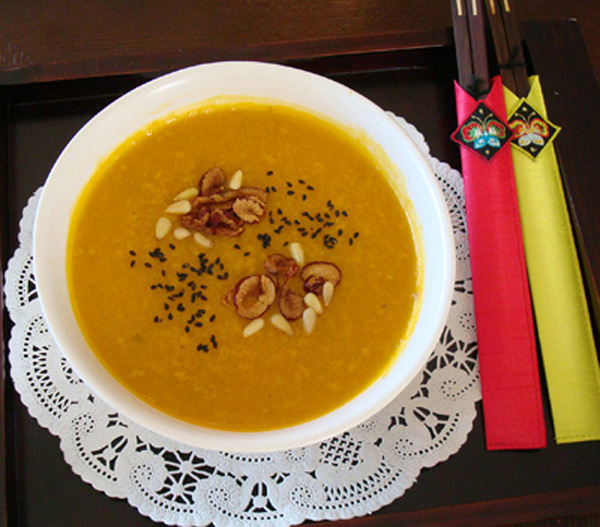
A quiet matriarchal figure, Hong is here seven days a week, 10 a.m. to 10:30 p.m., carefully preparing all the tea and all the food, such as hearty kabocha or abalone soup, and the most popular item – a huge bowl of green tea shave ice with green tea ice cream, mochi and fresh fruit that’s big enough for four people to share. She will even prepare a special menu if given advance notice.
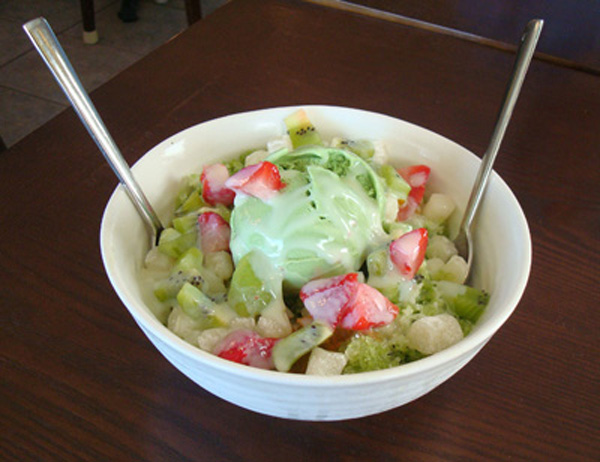
Until a month ago, Chasaengwon was the only game in town. Then, Puripan Tea Garden opened in Santana Row, as you read in yesterday’s blog posting. The former is steeped in tradition. Its simple wooden tables and chairs are filled with customers speaking Korean, Chinese, and Japanese. The latter is an airy, modern tea bar where you’re more likely to find fashionistas taking a break from shopping to enjoy a cup of fresh brew.
What they have in common is Ellen Kim, vice president of marketing for Puripan, Inc.’s Santa Clara office. Puripan is the largest fermentation company in Korea. It ferments more than 40 different kinds of fruits and vegetables to make condiments and tea drinks.
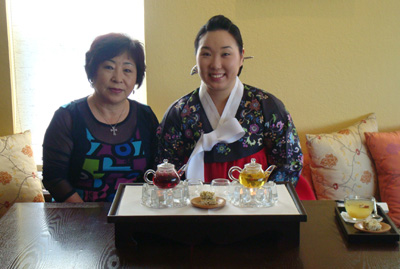
Kim is the proprietor of Puripan Tea Garden. But you’ll also often find her at Chasaengwon, where Puripan products are served, and where Kim performs exquisite tea ceremonies for free. Just reserve in advance and pay for the cost of the tea, usually $4.50 on up per person). It’s Kim’s way of educating people more about Korean culture.
On this day, she shows me nae bang da lye or “daily tea ceremony,” the typical one performed by housewives in Korea for three to five guests at a sitting. It’s best not to have more than five, Kim explains, so that the taste of the tea remains consistent from the first cup to the last.
A typical tea ceremony can be short or last as long as four hours. It is full of intricate movements embodying meaning and symbolism, from the way a cloth is lifted to the way a tea cup is cradled in the hands.
At the start, a two-sided cloth covers the tea set. The red side faces up, symbolizing the sun; the blue side is underneath, representing Earth. Together, they form the union of sky and land.
The cloth is lifted to reveal tea cups, tea saucers, a hot water pot, a water waste bowl, and a cooling bowl in which hot water is poured before being added to the tea leaves to ensure the water is at optimal temperature, 155 to 175 degrees for Korean green tea.
Kim will be serving Gamnong tea of young leaves, which has a delicate, much less tannic taste, and a lovely green color. She rolls the tea canister’s lip along the edge of a spoon hollowed out from an ornate piece of wood to measure out the leaves.
Water is poured into the cooling bowl in a deliberate way so that the stream of liquid moves from low to high to low again, creating a relaxing waterfall-like melody.
Kim grasps the cooling bowl with all 10 fingers because the digits represent family. By grasping the bowl like this, she explains, you hold the family “together” and create harmony.
The tea cups are lined up vertically in a row. The closest cup belongs to the preparer. The cup farthest away is for the guest of honor. It is filled last, so that the tea in that cup remains the hottest. Kim pours a little tea into each cup, starting with her own first, then going to the next, and the next, and finally to the guest of honor’s cup. She does it again, then a third time, until the cups are filled. The pour is broken up in this manner because each time the tea pot is tilted, it brews the tea leaves more. By pouring the tea in this way, you ensure that one cup is not stronger or weaker in taste than another.
The host takes a sip of tea first, much like a sommelier might taste a bottle of wine first before pouring for guests to ensure the quality is good. In ancient and more diabolical times, Kim says, the host also tried the tea first to assure guests there was no poison in it.
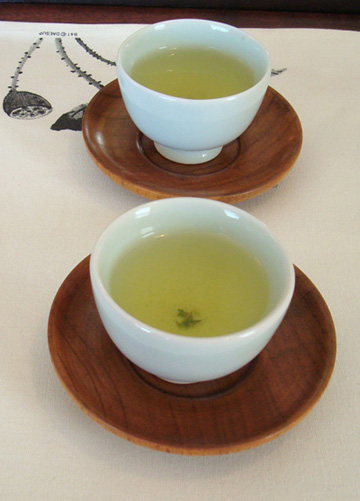
Finish the tea in the cup in three sips, because the number “3” signifies good luck in Korean.
Kim then brews a second pot of tea with the same leaves. The second brew is considered the best tasting because the tea leaves have opened up completely. Indeed, the color of the second brew is brighter and more vivid, and the flavor deeper. The leaves can be brewed a third and final time after that.
When all the tea has been consumed, the tea implements are returned to the tray just as they were at the beginning. The tea set is covered with the cloth, again red side up.
You can see more about a traditional Korean tea ceremony, by clicking on this YouTube video.
In our society of grab-and-go coffee, taking the time to sit down and slow down to enjoy tea in a hushed ceremony is a rarified treat. Do yourself a favor, and experience this tranquil ritual at least once. It’s like a soothing massage for the senses.

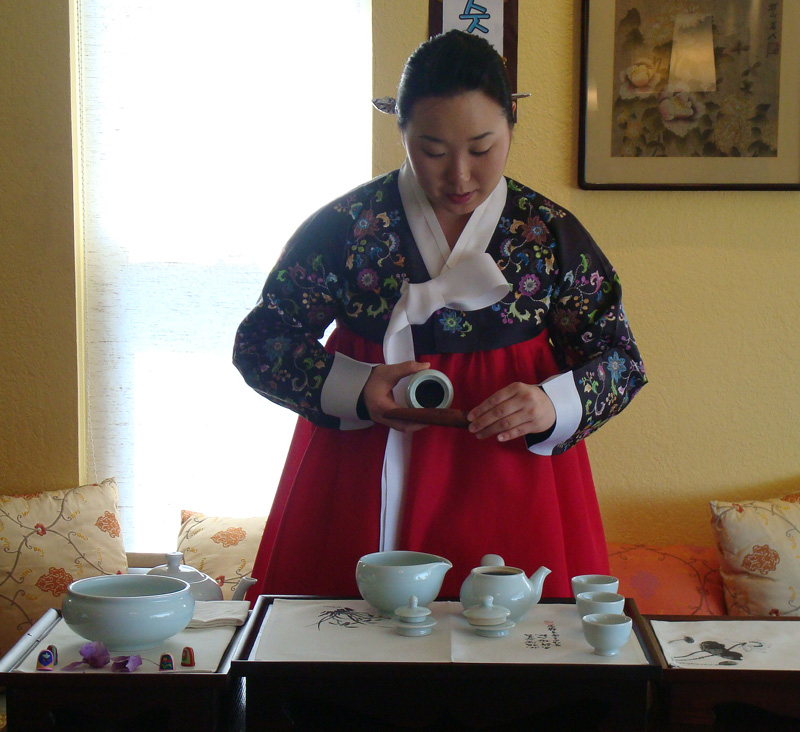
thanks for the posts. I’ve walked on ECR & noticed it when I looked up. Haven’t been yet but it’s on my growing list. Can’t wait to try it!
Ah, you and I both obviously have tea on the brain. Tell me the next time you head out for a tea ceremony as I’d love to tag along…
Wow, that looks fabulous. Annie and I have been through a Japanese tea ceremony before, but not Korean.
I don’t think the ceremony is kid-friendly, though, so that would be an issue.
Oh, I saw that place! Thought it odd, being an upstairs space. Kind of like someone’s apartment. It was evening and there was a warm glow, quite a few people you could see through the small windows. It seemed friendly but foreign in custom. Thank you for the write-up — I need to boldly go…
Nice, you’re officially now more Korean than I am.
I dunno, Steve. I still think you can eat a lot more spicy food than I can. 😉
I would love to try the icecream. I haven’t had green tea ice cream before with fresh fruits and shaved ice to boot. It would be perfect for summer!